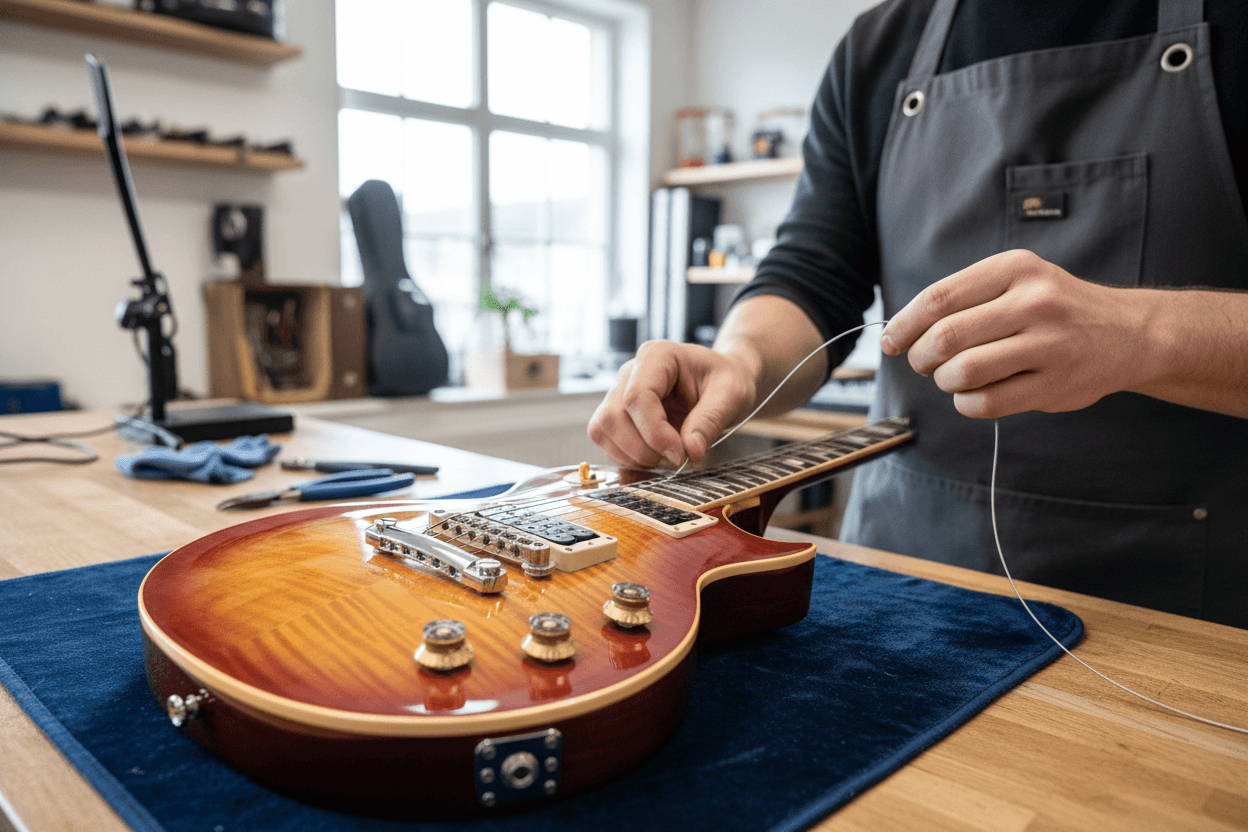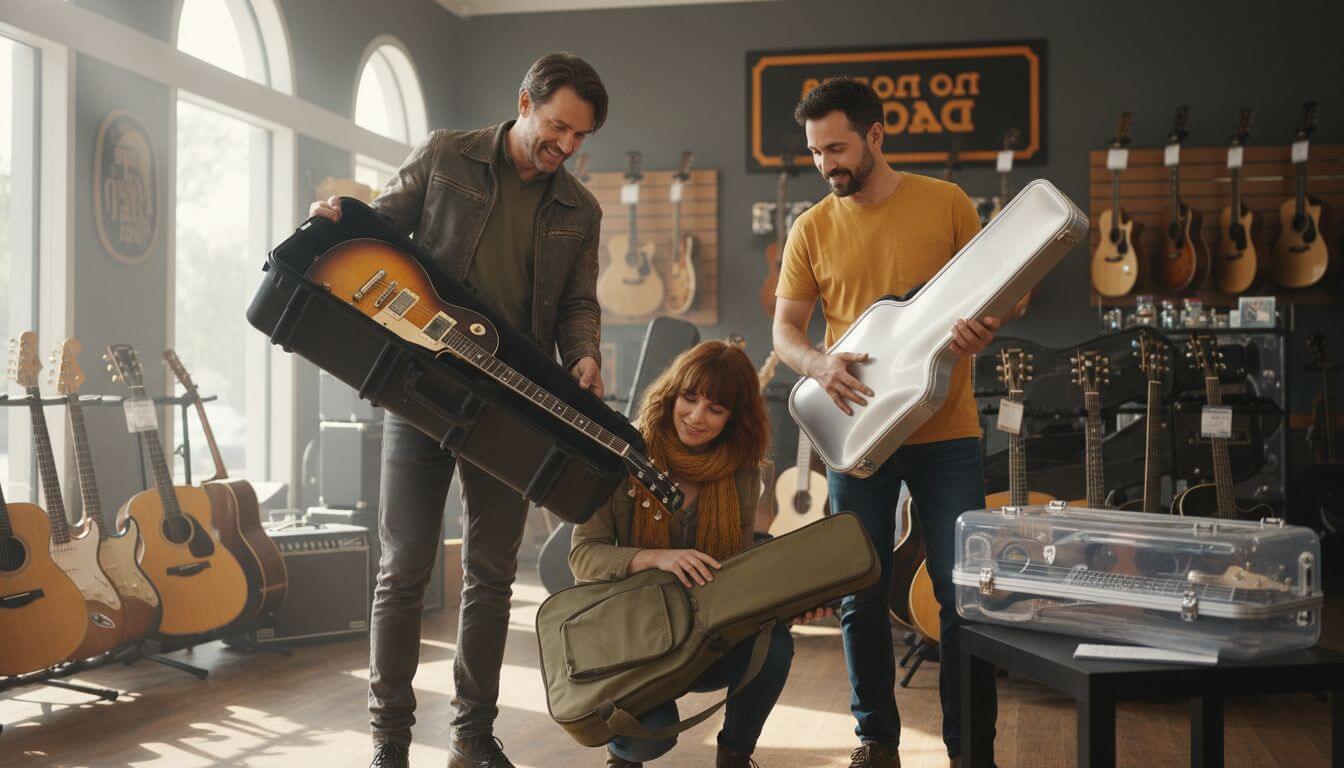Over 80 percent of guitar owners report noticing a dramatic difference after a professional setup. Even top-tier instruments can feel awkward to play or sound less impressive when small details are overlooked. Whether you are a beginner or a seasoned musician, understanding what a guitar setup really involves can help you get smoother playability, better sound, and a more satisfying musical experience.
Table of Contents
Key Takeaways
| Point | Details |
| Importance of Guitar Setup | A professional guitar setup optimizes playability, sound quality, and tuning stability, significantly enhancing the overall musical experience. |
| Key Steps in Setup | Essential adjustments include neck relief, action height, intonation, fretboard maintenance, and hardware checks to ensure optimal performance. |
| Customization for Styles | Guitar setups are tailored based on musical genres and playing styles, ensuring instruments respond well to specific techniques while improving playability. |
| Professional vs. DIY Setup | Investing in a professional setup is crucial; DIY efforts may lead to costly mistakes and adverse long-term effects on instrument performance. |
Defining Guitar Setup and Its Purpose
A guitar setup is a comprehensive process of fine-tuning your instrument to achieve optimal playability, sound quality, and performance. According to Sussex Guitar Setups, a professional guitar setup ensures that your instrument performs at its best, making it easier to play, improving tuning stability, and enhancing overall sound quality.
The primary goal of a guitar setup is to address various technical aspects that impact how an instrument feels and sounds. As Selborne Guitars explains, setting up a guitar involves optimising it for comfort, tuning, and playability. Musicians might seek a setup when experiencing common issues such as:
-
Strings feeling too high off the fretboard
-
Guitar not playing in tune across all fretboard positions
-
Unusual or uncomfortable playing experience
-
Inconsistent sound or intonation
A thorough guitar setup involves multiple precise adjustments that collectively transform an instrument’s performance. This includes carefully calibrating the neck relief, action height, intonation, string height, and truss rod tension. Professional guitar technicians meticulously assess and adjust these elements to ensure your instrument plays smoothly, stays in perfect tune, and sounds exceptional across different playing styles and musical genres.
Ultimately, a well-executed guitar setup is not just a technical procedure but an art form that bridges mechanical precision with musical expression. Learn more about professional guitar setups in our comprehensive guide on professional guitar setups.
Key Steps in a Complete Guitar Setup
A comprehensive guitar setup involves several critical adjustments that collectively enhance an instrument’s playability and sound quality. Professional guitar technicians follow a systematic approach to ensure every aspect of the instrument is optimised for peak performance. Learn more about guitar components in our comprehensive guide on electric guitar anatomy.
The key steps in a complete guitar setup typically include:
- Neck Relief Adjustment
-
Check and adjust the curvature of the guitar neck
-
Use a precision straightedge to measure neck curvature
-
Adjust truss rod to create optimal neck relief
- Action Height Calibration
-
Measure and adjust string height at the nut and bridge
-
Ensure consistent string height across the fretboard
-
Balance between low action for ease of playing and preventing string buzz
- Intonation Fine-Tuning
-
Verify and adjust each string’s pitch accuracy across the fretboard
-
Use electronic tuner to check notes at different fret positions
-
Adjust saddle positions for precise pitch reproduction

- Fretboard Maintenance
-
Clean and condition the fretboard
-
Check for fret wear and levelling
-
Ensure smooth playing surface without sharp edges
- Electronics and Hardware Check
-
Inspect and tighten all hardware components
-
Test and clean electronic connections
-
Lubricate moving parts like tremolo systems
Professional guitar setups require precision, patience, and a deep understanding of instrument mechanics. While experienced musicians might perform basic adjustments, complex setups are best handled by skilled technicians who can identify and resolve subtle issues that impact sound and playability. Check out our guide on identifying when your guitar needs a professional setup to understand when expert intervention becomes necessary.
Remember that each guitar is unique, and setup requirements can vary based on factors like playing style, guitar type, and environmental conditions. Regular maintenance ensures your instrument continues to perform at its best, delivering optimal tone and playing comfort.
Types of Guitar Setups and Their Benefits
Guitar setups are not a one-size-fits-all solution, but rather a nuanced approach tailored to different playing styles, musical genres, and instrument types. Learn more about professional guitar setup techniques in our comprehensive guide, which explores the intricate world of guitar maintenance and optimization.
The primary types of guitar setups can be categorized based on several key factors:
1. Genre-Specific Setups
-
Rock/Heavy Metal Setup
-
Lower action for fast playing
-
Increased neck relief to prevent fret buzz
-
Optimised for distortion and high-gain sounds
-
-
Jazz/Blues Setup
-
Higher action for more pronounced string vibration
-
Enhanced sustain and cleaner tone
-
Precision intonation for complex chord voicings
-
-
Classical/Acoustic Setup
-
Balanced action for fingerstyle playing
-
Careful neck relief to accommodate nylon or steel strings
-
Focus on natural acoustic resonance
-
2. Playing Style Setups
-
Shredder’s Setup
-
Ultra-low action
-
Perfectly levelled frets
-
Smooth neck feel for rapid lead techniques
-
-
Slide Guitar Setup
-
Higher action to prevent string contact with frets
-
Adjusted nut height for smooth slide movement
-
Modified neck relief for optimal slide performance
-
3. Instrument-Specific Setups
-
Electric Guitar Setup
-
Precise electronic component adjustment
-
Pickup height calibration
-
Hardware and tremolo system optimization
-
-
Acoustic Guitar Setup
-
Bridge and saddle height adjustment
-
Wood preservation and humidity considerations
-
Truss rod tension for optimal neck stability
-
Each setup type offers unique benefits that can dramatically improve an instrument’s playability and sound quality.
The right setup transforms a good guitar into an exceptional musical instrument, allowing musicians to unlock their full potential and express their artistic vision with precision and comfort.
How Setup Affects Playability and Tone
Guitar setup is a critical process that profoundly influences both the instrument’s playability and tonal characteristics. According to Lab Project, a proper setup involving adjustments to neck relief, action height, and intonation can significantly enhance sustain, clarity, and overall tonal balance. For beginners especially, a well-executed setup can make the difference between a frustrating playing experience and a joyful musical journey.
Impact on Playability
-
Reduced finger fatigue
-
Smoother string movement
-
Enhanced fretting precision
-
Decreased physical resistance while playing
Tonal Transformation Mechanisms
-
Neck Relief: Influences string vibration and note clarity
-
Action Height: Determines string tension and sustain
-
Intonation: Ensures precise pitch across the fretboard
-
Truss Rod Adjustment: Controls overall neck resonance
The nuanced relationship between setup and tone is particularly evident in different playing techniques. A lower action, for instance, facilitates easier fretting and can produce a more fluid playing experience, especially for techniques like legato and fast lead runs. Conversely, a higher action might provide more dynamic range for fingerstyle or blues techniques, allowing for more pronounced string vibration and harmonic complexity.
Dive deeper into understanding your perfect guitar tone with our comprehensive guide, which explores the intricate relationship between setup and sound. Professional musicians understand that tone is not just about the gear, but about how meticulously the instrument is prepared to respond to your unique playing style.
Ultimately, a guitar setup is an art form that bridges mechanical precision with musical expression. By carefully adjusting each component, guitarists can unlock their instrument’s full potential, transforming a good guitar into an exceptional musical voice that feels like a natural extension of their creativity.
Cost, Risks, and Common Setup Mistakes
Guitar setups represent a critical investment in your instrument’s long-term performance and sound quality. While professional setups can range from £50 to £250 depending on complexity, attempting a do-it-yourself approach carries significant risks for inexperienced musicians. Learn more about professional guitar maintenance in our comprehensive guide.
Common Setup Mistakes to Avoid
- Truss Rod Adjustment Errors
-
Over-tightening can cause irreversible neck damage
-
Under-adjustment leads to poor neck alignment
-
Requires precise, incremental quarter-turn adjustments
- Incorrect Action Height Calibration
-
Too low: Increased string buzz and potential fret damage
-
Too high: Reduced playability and increased finger fatigue
-
Requires millimetre-precise measurements
- Improper Intonation Tuning
-
Failing to use electronic tuner for precise measurements
-
Neglecting individual string compensation
-
Ignoring scale length variations
Financial Considerations and Risk Management
Professional Setup Costs
-
Basic setup: £50 - £100
-
Comprehensive setup: £150 - £250
-
Complex repairs: £250 - £500
Potential Risks of DIY Setup
-
Permanent neck damage
-
Costly instrument repairs
-
Reduced resale value
-
Compromised playing experience
For musicians uncertain about their technical skills, professional setup remains the safest and most reliable option. Expert technicians possess the specialized tools, knowledge, and experience to make precise adjustments that protect your instrument’s integrity and optimize its performance.

Ultimately, viewing a professional setup as an investment rather than an expense can save significant money and potential heartache in the long run. A well-maintained guitar not only sounds better but also preserves its value and ensures a consistently enjoyable playing experience.
Unlock Your Guitar’s True Potential with Expert Setups
If you have ever struggled with high action, poor intonation, or inconsistent tone as discussed in our detailed guide on “Guitar Setup Explained: Optimising Playability and Tone”, you are not alone. Many guitarists face challenges like uncomfortable playability and tuning instability that can hold back their musical expression. At MusicStreet.co.uk, we understand how crucial precise adjustments such as neck relief calibration, action height setting and intonation tuning are for transforming your guitar into a powerful extension of your creativity.

Explore our carefully selected range of premium guitars and specialised accessories to match your setup needs, or bring your instrument to our Huntingdon store for professional servicing and repairs. Don’t wait until playability issues affect your practice or performance. Visit us today at MusicStreet.co.uk and discover our expert advice and comprehensive services including bespoke guitar setups tailored to your style. Take the first step towards a flawless playing experience and ensure your guitar sounds as good as it looks.
Frequently Asked Questions
What is a guitar setup?
A guitar setup is a comprehensive process of fine-tuning the instrument to optimize playability, sound quality, and performance by adjusting elements such as neck relief, action height, intonation, and truss rod tension.
How often should I get my guitar setup?
It’s recommended to get your guitar setup at least once a year or whenever you notice issues like high string action, tuning instability, or discomfort while playing.
What adjustments are involved in a complete guitar setup?
A complete guitar setup typically includes neck relief adjustment, action height calibration, intonation fine-tuning, fretboard maintenance, and inspection of electronics and hardware.
Can I perform a guitar setup myself?
While basic adjustments can be done by experienced musicians, complex setups are best handled by professional technicians to avoid potential damage and ensure optimal performance.




Share:
7 Essential Tips for Building Guitar Effects Chains
How to Buy Used Guitars: A Complete Guide for Musicians